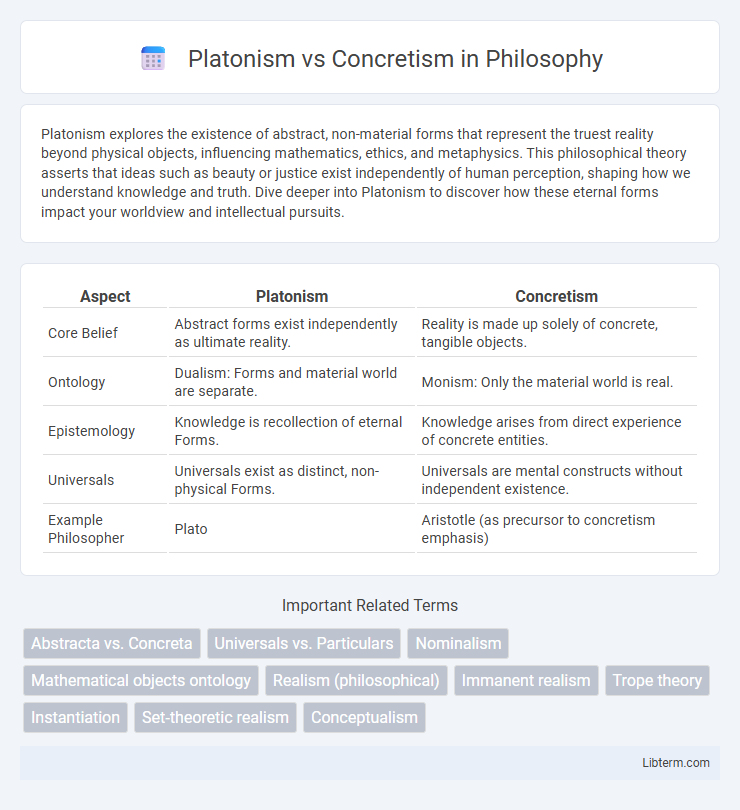Platonism explores the existence of abstract, non-material forms that represent the truest reality beyond physical objects, influencing mathematics, ethics, and metaphysics. This philosophical theory asserts that ideas such as beauty or justice exist independently of human perception, shaping how we understand knowledge and truth. Dive deeper into Platonism to discover how these eternal forms impact your worldview and intellectual pursuits.
Table of Comparison
| Aspect | Platonism | Concretism |
|---|---|---|
| Core Belief | Abstract forms exist independently as ultimate reality. | Reality is made up solely of concrete, tangible objects. |
| Ontology | Dualism: Forms and material world are separate. | Monism: Only the material world is real. |
| Epistemology | Knowledge is recollection of eternal Forms. | Knowledge arises from direct experience of concrete entities. |
| Universals | Universals exist as distinct, non-physical Forms. | Universals are mental constructs without independent existence. |
| Example Philosopher | Plato | Aristotle (as precursor to concretism emphasis) |
Understanding Platonism: The Realm of Abstract Forms
Platonism asserts the existence of a non-physical realm of abstract Forms or Ideas, which are perfect, immutable templates of all objects and concepts in the material world. These Forms exist independently of human thought and provide the foundation for objective knowledge, with the physical world seen as a mere shadow or imperfect copy. Understanding Platonism involves recognizing that true knowledge arises from the intellectual apprehension of these eternal Forms rather than sensory experience.
Defining Concretism: Emphasis on Physical Realities
Concretism centers on the belief that reality is fundamentally grounded in tangible, physical objects rather than abstract entities, prioritizing sensory experience and material existence. This philosophical perspective challenges Platonism by rejecting the existence of non-empirical forms or universals, emphasizing instead the primacy of concrete particulars that can be observed and measured. Concretism asserts that knowledge and truth emerge from interaction with the physical world, making empirical evidence the cornerstone of understanding reality.
Historical Origins of Platonism and Concretism
Platonism originated in ancient Greece with the philosopher Plato, who asserted that abstract forms or ideas are the most real and fundamental aspects of reality, existing independently of the physical world. Concretism, emerging as a response within 20th-century philosophical discussions, emphasizes concrete particulars and tangible entities as reality's basis, contrasting Platonism's focus on abstract universals. The historical origins of Platonism are deeply rooted in classical metaphysics, whereas Concretism has evolved through modern philosophical inquiries into ontology and epistemology.
Core Philosophical Distinctions
Platonism asserts the existence of abstract, immutable entities that exist independently of human thought, emphasizing universality and non-empirical reality. Concretism, on the other hand, holds that only concrete, tangible objects and their instances truly exist, rejecting the reality of abstract forms or universals. The core philosophical distinction lies in whether abstract objects possess objective existence (Platonism) or are merely conceptual constructs without independent reality (Concretism).
Platonism in Mathematics and Logic
Platonism in mathematics and logic asserts the existence of abstract, non-empirical entities such as numbers and mathematical truths as timeless and independent of human cognition. Mathematical objects are discovered rather than invented, reflecting an objective reality that underlies logical structures and proofs. This view contrasts with concretism, which grounds mathematical concepts in physical, empirical instances or mental constructions.
Concretism’s Influence in Art and Literature
Concretism in art and literature emphasizes tangible reality, focusing on sensory experience and material presence rather than abstract ideals. This movement influenced modernist artists and writers by encouraging direct engagement with physical forms and concrete objects, inspiring works that prioritize clarity, precision, and the immediacy of perception. The rejection of Platonic idealism in favor of experiential authenticity shaped notable practices in visual arts, poetry, and prose, fostering innovation rooted in the factual and the observable.
Debates: Abstract Universals vs Tangible Objects
Platonism asserts that abstract universals exist independently of tangible objects, positing that these forms represent the highest reality beyond physical manifestations. Concretism challenges this by emphasizing the reality of tangible objects, arguing that universals cannot exist without particular instances in the physical world. The debate centers on whether abstract entities have an existence separate from the material world or if universals are merely conceptual constructs derived from concrete experiences.
Modern Perspectives on Platonism and Concretism
Modern perspectives on Platonism emphasize its role in the philosophy of mathematics by asserting the existence of abstract mathematical objects independent of human thought, reinforcing the ontological commitment to universals and abstract entities. Concretism challenges this by advocating that mathematical objects are fundamentally tied to concrete physical or mental constructions, grounding mathematical truth in tangible or experiential reality. Contemporary debates often explore cognitive science and philosophy of language to assess how Platonism and Concretism account for mathematical knowledge, meaning, and application in both theoretical and applied contexts.
Applications in Science and Epistemology
Platonism in science emphasizes the existence of abstract mathematical entities as the foundation of physical laws, guiding theoretical physics and the search for universal truths. Concretism, contrastingly, prioritizes empirical data and observable phenomena, shaping experimental methodologies and pragmatic epistemology. These approaches influence scientific inquiry by balancing the pursuit of ideal forms and practical verification in knowledge acquisition.
Future Directions and Ongoing Discussions
Future directions in the Platonism vs Concretism debate emphasize advancing metaphysical frameworks to reconcile abstract object realism with ontological parsimony. Ongoing discussions explore integrating cognitive science insights to better understand how humans engage with abstract entities versus concrete instances. Emerging interdisciplinary approaches aim to refine criteria for existence and representation, potentially reshaping foundational concepts in philosophy of mathematics and metaphysics.
Platonism Infographic

 libterm.com
libterm.com